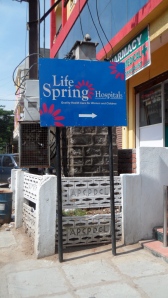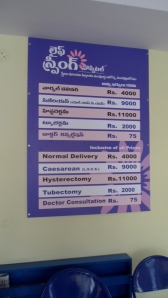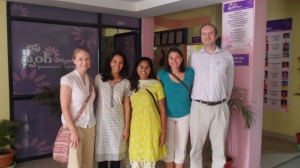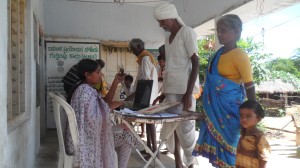While I’m perusing the magazines at an O’Hare bookstore, waiting for my final flight back to Cleveland, I come across this week’s issue of The Economist. Ironically, the cover is about India. I open the magazine to the article focusing on how private companies & small businesses are the drivers behind India’s economic growth. The article reflects on the problems facing India’s economy, but also remarks on private industry’s ability to create “novel ways to make management more responsive to customers”. This statement is apropos for our last clinical visit at a LifeSpring hospital.
LifeSpring hospitals (LSH) are a group of private hospitals utilizing effective business practices to
provide quality women’s health care to low-income populations. Much like HMRI, I find learning about LSH exciting, as “it is serving the poor through business”. LSH is also one of the best examples of minimizing cost while maximizing quality and access in health care delivery (indeed, multiple case studies have been written on the LifeSpring model, including one by Columbia Business School; check out the web site http://www.lifespring.in/). It achieves this maximization through its mission and focus, which creates a unique health care company culture in India and requires meticulous planning. The major areas of focus, in order of importance at LSH, are quality, price, and growth.
In addition to the quoted line in the previous paragraph, “never compromise quality” is one of the comments made to us by Priya, a young, vibrant, & knowledgeable assistant manager at LSH, as well as our hostess for the visit. She gives us a tour of one of the hospitals where the corporate office is also located. Quality, as well as transparency and terminology, are what
define the company culture at LSH. We see this at the beginning of our tour, where Priya shows us the equivalent of a patients’ bill of rights. On one long corridor, posters line the walls explaining the quality, services, and prices customers can expect. Nowhere else have we seen such transparency. Nor have we heard of patients referred to as customers. Priya explains, “pregnancy is a condition, not a disease.” Not surprisingly, providers have the most difficultly in using this word. However, according to Priya, staff and patients don’t notice the difference in terminology. Instead, customers appreciate the difference in care and quality. With the patient as a customer, the staff has a customer-first mentality that puts the needs of patients first, a concept that is not as evident at other institutions. Furthermore, as customers pay for services, this model avoids the potential for moral hazard that can be associated with free services.
Like HMRI, LifeSpring also monitors its quality. The head of clinical quality, Dr. Rama, spoke with us about the international guidelines (NICE > ACOG) and quality measures
(IHI) that LSH uses to establish its best practices. In addition to surveying customers via the call center, its top quality indicators include infant and maternal morbidity/mortality (in absolute numbers, India has the highest maternal mortality rate), postpartum infection, overstay, and primary cesarean section. It’s important to keep in mind that LSH specializes in vaginal deliveries and cesarean sections; it refers IVF, high risk, VBAC, & HIV cases and currently does not provide gynecological or preventive health care (ie yearly well woman’s exam).
The second major focus of LSH is affordable pricing. The target market is women who earn US$3-5 daily. LSH defines affordability as one month’s income. I found it interesting that although government hospitals are “free”, patients are expected to pay tips to staff (housekeeping, nursing, clerks, etc). The costs of these tips can reach INR 3000 and quality, sometimes even a bed, is not guaranteed. At LSH, the cost of delivery is INR 4000. Priya notes that pregnancy is an assumed family cost in
Indian culture given the emphasis on childbearing. As such, customers typically prepare for this cost. Because of its cultural and general importance, Priya says, “women want a quality delivery”. At LSH, customers have a three-tier choice for delivery: first tier is the general ward (lowest cost, 80% of customers choose this tier); second tier is a semi-private room (double occupancy), third tier is a private room (most expensive). Each hospital has at least 20 beds, with 30 beds available at the original facilities. Operations are based on a high throughput model. Length stay is typically 3 days for a vaginal delivery and 5 days for a cesarean. Like other facilities, fees are collected before services are rendered, but an option exists (on a case by case basis) for payment afterwards. A fund is also available for women who deliver, but are unable to pay. As of yet, no woman has been turned away. Maintaining such quality while charging low prices keeps the margins low. Priya notes that management must be innovative to keep the company sustainable. With 50% market share, the organizational mission to help those in need, and quality and sustainability as top goals, it’s easy to understand why innovation is crucial.
To keep up with demand, LSH plans on developing 6 more hospitals this year. Priya refers to this growth as bulk expansion. LSH performs market analysis through its community outreach program prior to selecting new hospital sites. Each hospital serves no more than a 5 km radius in a densely populated area. Extending the parameter would increase opportunity costs to its customers (ie increased travel costs) and would not support its mission.
On the growth-share matrix, LSH is a star given its high growth rate and high market share. It’s not surprising that margins are low, as by definition, a star’s income is used to support its growth and meet its mission. LSH not only identified a new market, it created one and is set up to eventually become a cash cow. When the organization reaches this stage where growth slows and market share (hopefully) remains the same, its margins will likely increase. At that time, perhaps the company can expand to other women’s health areas, such as gynecological exams or preventive health. For now, they are filling a tremendous need by keeping a sharp focus on deliveries.
Many undergraduate students in the US choose medicine with the desire to help people. While I was making this decision, I had physicians tell me not to pursue medicine as it is now a business. They’re right. Even if heavily regulated by a government, the delivery of medicine is a business. NGOs, governments, private institutions all have to manage their assets, debts, and expenditures in order to remain sustainable and reach their mission (which is hopefully to help people). But this necessity shouldn’t keep one from pursuing the practice of medicine; instead, one should at least be aware of how business influences the practice of medicine before making the dedication inherent to medical training. I believe it is important to realize that personal and organizational success in helping people is largely due to the environment and systems in which we work, in addition to one’s personal work ethic and determination. The efficiency, innovation, mission & culture of HMRI and LSH in delivering health care to the poor and underserved are what make them so exciting to me. These are also reasons why they perfectly fit the description provided by The Economist. Seeing the success of these private institutions “using business to help the poor” obtain quality health care is invigorating to me. As a result, I’ll take what I’ve seen and learned during this trip and adapt it to the environments where I practice … which I believe is the purpose of such international medical electives.
Overall, this has been an incredible, well-rounded, educational, fun experience that allowed us to
intensely evaluate health care delivery in India and experience Indian culture. As Gomes pointed out during our final day, we were in India during the Festival of Ganesha, the Ayodhya verdict, the national holiday celebrating Gandhi’s birthday, and the beginning of the Commonwealth Games. These events, in addition to our clinical experiences, provided a wide range of experiences, emotions, and discussions. What truly defined this experience are the people who were part of it. I value most my friends and the people that we met, including Shobha, Neena Auntie, Kumar, and all the amazing providers, leaders, patients and children. I’ll miss being able to walk out of a room and having someone to talk with who had the same experience that day, but presents a different perspective. I’ll miss our family-style dinners and their associated discussions and shenanigans (don’t make Gomes laugh while she’s eating). I’ll miss learning daily about the small things that make my friends great. I’m so happy to have been part of this experience and to be able to share it with people at home through this blog and other social networks. I recommend similar traveling to anyone who is willing to get out of his or her comfort zone and keep an open mind, especially if they’re able to travel with friends.



















 the random shack with its unique features or a group of women in saris, the scenery looks like we could be driving through the fields and farmland in the midwest (the old highways surrounding I-70 in Southern Illinois come to mind, especially with the various crops growing on each side of the road). There’s even the occasional smell of “fertilizer” as we roll down the window to snap a few photos. Overall, though, the air smells and feels incredible. It’s nice to be out of the city’s smog.
the random shack with its unique features or a group of women in saris, the scenery looks like we could be driving through the fields and farmland in the midwest (the old highways surrounding I-70 in Southern Illinois come to mind, especially with the various crops growing on each side of the road). There’s even the occasional smell of “fertilizer” as we roll down the window to snap a few photos. Overall, though, the air smells and feels incredible. It’s nice to be out of the city’s smog.




